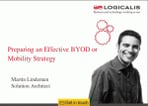Consider these startling facts:
- One of Logicalis’ large enterprise customers has experienced a 102% mobile device growth rate within their corporate network over a span of two years.
- Cisco’s research predicts that by 2015 we will own 15 billion devices, with the average person owning 3 devices or more.
These are staggering figures, and yet no-one seems particularly surprised, mostly because we know from our own lives and anecdotal evidence all around us, that mobile devices sell like popcorn nowadays. The implications for corporate Australia are noteworthy and underpin the need for a robust BYOD strategy to take control of the explosion of devices.
A webinar by Martin Lindeman, a Logicalis Solutions Architect, outlines the why and how to develop an effective strategy for enabling secure mobility or BYOD.
The genesis of BYOD
The main driver for BYOD is mobility: people find themselves becoming more mobile and more productive both in and outside of the workplace due to the power and flexibility of their own mobile devices. It makes sense that users are inclined to use the same mobile device, regardless of their workplace.
With mobility and productivity at their fingertips, more and more employees question being tied to a desk for one half of their waking lives. Sitting behind a desk (and a desktop computer) seems restrictive. A number of surveys have seen strong positive correlations between employee attraction, satisfaction and retention and an organisation's flexible approach to devices. For these reasons, many more businesses have embraced the BYOD trend - or gone one step further and are providing a choice of corporate mobile device.
What does this mean?
If an organisation's employees are to have access to any data, any time on any device - where devices may or may not be personally owned and are not corporate assets in the traditional sense - what new business challenges does this present?
- A Paradigm shift
With mobility, a workspace evolves from a desk in an office, to a café or a home office. Employees are increasingly moving away from the ‘working from 9 to 5 at an office, to one where they can work anywhere and any time they’d like. This presents challenges for managers used to operating a command and control management style, rather than one that emphasises output and results. - Data security.
Research suggests that 60% of mobile users download sensitive data on their personal devices. Therefore data security becomes a sigificant concern amongst IT managers - Malware:
The number of mobile malware incidents has quadrupled between 2010-2012 - with the increasing amount of malicious code targeting mobile devices, businesses need to be vigilant.
As with any new implementation, BYOD comes with risks. But when implemented properly, the risks can be managed and the returns can be high.
How to develop an effective strategy
Martin outlined the following steps to set a high-level strategy that mitigates the risks and maximises the benefits of BYOD:
1. Develop a business case
The first and most crucial step is to look at how BYOD fits within your overall strategic direction and define the core reasons for adoption. BYOD is not always suitable or even necessary (Defence and some government departments are classic examples of this). Then look at the business’ current state and assess your Total Cost of Ownership (TCO), upfront investment for BYOD and ongoing operating costs. Then calculate the potential savings and generate an estimated ROI.
2. Workforce segmentation
When it comes to BYOD, look beyond employees and also take into account third party contractors and suppliers. Organisations should consider everyone who has a need to engage with your organisation. You will need to review their roles and their interaction process and how BYOD can increase efficiency and productivity , as well as assessing areas of risk.
3. Create a service strategy
The workforce segmentation will help you form the service strategy, i.e., the type of connectivity needed and the relevant service policies to be applied for those particular groups. Devices may include laptops, desktops, end point solutions and full on mobile solutions as well as non-corporate-issue devices. Combine these to have a clear and complete understanding of your needs and determine the best service strategy for your organisation.
4. Define policies
With a clear strategy, you can then define use policies. The IT department should be driving the policy design and getting buy-in from HR, Finance, Tax, Legal and Corporate Security. To mitigate security risks, clearly define rules of use: acceptable actions, handling specific scenarios and mandated processes. Ensure you address security measures such as password protection, remote data wiping and required actions to take if a device is lost or stolen. Refrain from using IT jargon and stick with plain English to maximise clarity, as you will be communicating with users with varying degrees of technological understanding.
5. Develop user support model
To ensure smooth integration, a clear reliable support model is essential. Assign different support roles to the correct parties. For instance, IT provides support for connectivity issues with corporate applications and operating systems while hardware support is provided by the manufacturer. Your BYOD policy should encourage users to help themselves by giving them direct access to online groups, community support forums and best practice wikis.
BYOD is here to stay, so businesses need to acknowledge this and take action. You can take a variety of approaches on a spectrum from restricting it, to allowing it, to encouraging it and possibly even mandating it. At the very least, businesses need to set clear guidelines and rules of use.
Watch the webinar or view the presentation on slideshare to gain a deeper insight into the how to develop a robust BYOD strategy, or contact us to help you commence and navigate your BYOD journey.





